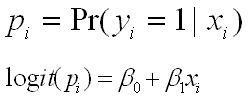
Where is a 2 category dependent variable to
indicate voter turnout. It takes the value 1 if the individual (subscript i) turned out to vote in
the
most recent election in their country and 0 if they did not.
is a 2 category dependent variable to
indicate voter turnout. It takes the value 1 if the individual (subscript i) turned out to vote in
the
most recent election in their country and 0 if they did not. is the
probability
that the person turns out to vote (
is the
probability
that the person turns out to vote ( ) given
some explanatory variable information we have about the individual,
) given
some explanatory variable information we have about the individual, .
This
could be their age, gender, highest level of education etc. the explanatory variables can be
interval
scale, categorical or a mixture of the two. In this theoretical discussion we will assume that
.
This
could be their age, gender, highest level of education etc. the explanatory variables can be
interval
scale, categorical or a mixture of the two. In this theoretical discussion we will assume that  is an interval scale explanatory
variable:
age in years. The overall variation in voter turnout is denoted by Var
is an interval scale explanatory
variable:
age in years. The overall variation in voter turnout is denoted by Var  .
.
Graphical interpretation: the graph below shows how this model works. One straight line is fitted to the data, relating the log of the odds of turning out to vote (vertical axis i.e. the y axis) to age (horizontal axis i.e. the x axis). In this model no country-level information is used; the assumption is that the same relationship applies for all 22 European countries.

Interpretation in words: we can use this model to relate the chance of someone voting to their age. If there is an increased chance of voting as people get older the line will have a positive slope as shown in the graph above.



